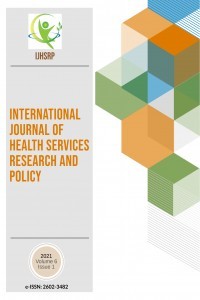ULTRASTRUCTURAL EXAMINATIONS ON DIABETIC RAT SKIN TISSUE WITH TOPICAL APPLICATION OF Salvia euphratica ETHANOL EXTRACT
ULTRASTRUCTURAL EXAMINATIONS ON DIABETIC RAT SKIN TISSUE WITH TOPICAL APPLICATION OF Salvia euphratica ETHANOL EXTRACT
Diabetes, Salvia euphratica, Wound Healing, Ultrastructure,
___
- Referans1 Tsioutsiou, E., Miraldi, E., et al., Skin Wound Healing: From Mediterranean Ethnobotany to Evidence based Phytotherapy, Athens Journal of Sciences, (2017), 4, pp. 199-211.
- Referans2 Bandaranayake, W. M., Quality control, screening, toxicity, and regulation of herbal drugs, Modern Phytomedicine. Turning Medicinal Plants into Drugs eds Ahmad I., Aqil F., Owais M., John Wiley and Sons Inc., New York, USA, pp. 25–57.
- Referans3 Bamidele, O., Kolawole, J.T., et al., Wound Healing Potentials of Aqueous Leaf Extract of Mangifera indica L. in Wistar Rats. Journal of Complementary and Alternative Medical Research 2 (2017), pp. 1-11.
- Referans4 Dorai, A.A., Wound care with traditional, complementary and alternative medicine. Indian Journal of Plastic Surgery, 45 (2012), pp. 418-424.
- Referans5 Nagar, H.K., Srivastava, A.K, et al. Pharmacological Investigation of the Wound Healing Activity of Cestrum nocturnum (L.) Ointment in Wistar Albino Rats. Journal of Pharmaceutics, (2016), ID 9249040.
- Referans6 Nguyen, V.L, Truong, C-T., et al. Anti-inflammatory and wound healing activities of calophyllolide isolated from Calophyllum inophyllum Linn. PLoS ONE. (2017), 12(10):e0185674.
- Referans7 Greenhalgh, D.G. Wound healing and diabetes mellitus. Clinical Plastic Surgery, 30 (2003), pp. 37 – 45.
- Referans8 Trengove, N.J, Stacey, MC, et al. Analysis of the acute and chronic wound environments: the role of proteases and their inhibitors. Wound Repair Regeneration, (1999), 7, pp. 442– 452.
- Referans9 Alimpic-Aradski, Knezevi, A., et al., Biological activities and chemical composition of Salvia amplexicaulis Lam. Extracts. Industrial crops and products, 105, (2017), 1-9.
- Referans10 Narayan, S., Sasmal, D., et al., Evaluation Of The Wound Healing Effect Of Herbal Ointment Formulated with Salvia Splendens (Scarlet Sage) International Journal of Pharmarcy Science, 3, (2011), 195-199.
- Referans11 Estakhr, J. and Javdan, N., Evaluation of Wound Healing Activity of Salvia hypoleuca extract on Rats. Pharmacologyonline (2011), 3, pp.622-625.
- Referans12 Suntar, I., Akkol, E.K., et al. Investigating wound healing, tyrosinase inhibitory and antioxidant activities of the ethanol extracts of Salvia cryptantha and Salvia cyanescens using in vivo and in vitro experimental models. Journal of Ethnopharmacology, (2011), 135, pp.71-77.
- Referans13 Hayat, M.A., Principles and Techniques of Electron Microscopy, Biological Applications. Cambridge University Press, Cambridge, UK, 2000.
- Referans14 Frangez, I., Cankar, K., Frangez, H.B., Smrke, D.M., The effect of LED on blood microcirculation during chronic wound healing in diabetic and non-diabetic patients-a prospective, double-blind randomized study. Lasers in Medical Science, 32, (2017), pp.887-894.
- Referans15 Medagama, A.B, Bandara, R., The use of complementary and alternative medicines (CAMs) in the treatment of diabetes mellitus: is continued use safe and effective? Nutrition Journal, 13, (2014), pp.1-9.Referans16 Komesu, M.C., Tanga, M.B., Buttros, K.R., Nakao, C., Effects of acute diabetes on rat cutaneous wound healing. Pathophysiology, (2004), pp.63-67.
- Referans17 Geddes, A.M., Pithie, A.D., Infection in the diabetic patient, in: M. Brownlee, L.M. Sherwood (Eds.), Diabetes Mellitus and Its Complications: Pathogenesis and Treatment, Hanly & Belfus Inc., Philadelphia, 1990.
- Yayın Aralığı: Yılda 3 Sayı
- Başlangıç: 2016
- Yayıncı: Rojan GÜMÜŞ
INTERESTS AND OPİNİONS OF THE SOCİETY ON HEALTH NEWS AND PROGRAMS: A SAMPLE STUDY İN TRABZON
Sedat BOSTAN, Beyler YETKİNER, Tuğba ÇOLAK
Evaluation of Diastolic Dysfunction in Rheumatoid Arthritis Patients
Özge Turgay Yıldırım, Emel Gönüllü, Fatih Aydın, Ercan Akşit, Ayşe Hüseyinoğlu Aydın, Evrin Dağtekin
CHANGABLE ENVIRONMENTAL RISK FACTORS IN AUTISM: VITAMIN D AND FOLIC ACID
Ebru GOKALP-OZKORKMAZ, Nursel GUL, Yusuf OZAY, Sevda GUZEL, Ahmet KAHRAMAN, Hakan ESKIZENGIN
Fatma Başar, Seher Şeyma Hürata
FOSTER PARENT’S MOTIVATIONS REGARDING FOSTER CARE: A CROSS-SECTIONAL STUDY FROM SOUTH INDIA
Kurian JOSE, Benil HAFEEQ, Sheeba MUMTAZ, P.j. ANJALİ, N.a. UVAİS
